The Samsung Galaxy Note 4 Review
by Joshua Ho on October 15, 2014 9:00 AM EST- Posted in
- Smartphones
- Samsung
- Android
- Mobile
- Galaxy Note 4
Battery Life
Battery life is one of the most important aspects of any mobile device, especially because the battery is what defines mobility to begin with. As a result, it’s important to test battery life in a meaningful manner. This requires a repeatable test with standardized conditions, and a range of scenarios that stress different aspects to get the full picture. Most importantly, for tests that have the display on we calibrate the display to 200 nits to ensure that the test doesn’t penalize brighter displays. In the case of the Galaxy Note 4, we see about a 3% gain in battery capacity, so most of the battery life gains should come from higher efficiency.
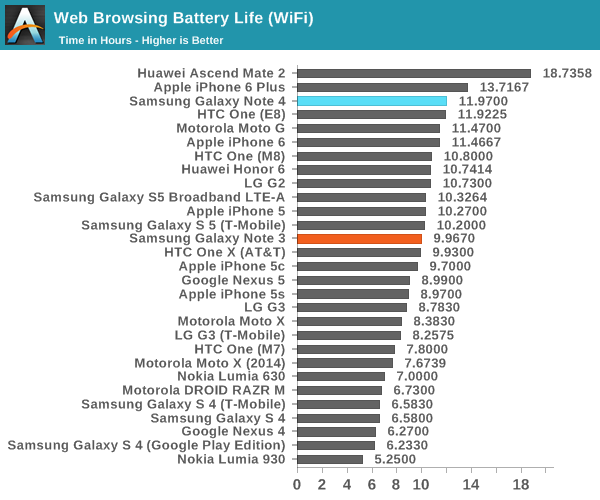
Our first test is the WiFi web browsing test, which loads a given set of web pages in a loop, with special emphasis taken in order to ensure that the test doesn’t penalize faster SoCs, which would have significant effects on our results. As one can see above, the Galaxy Note 4 has a noticeable uplift in battery life when compared to the Galaxy S5 and lasts significantly longer than the Galaxy Note 3. It doesn’t last quite as long as the iPhone 6 Plus, but few people should have issues getting through a full day of intensive use.
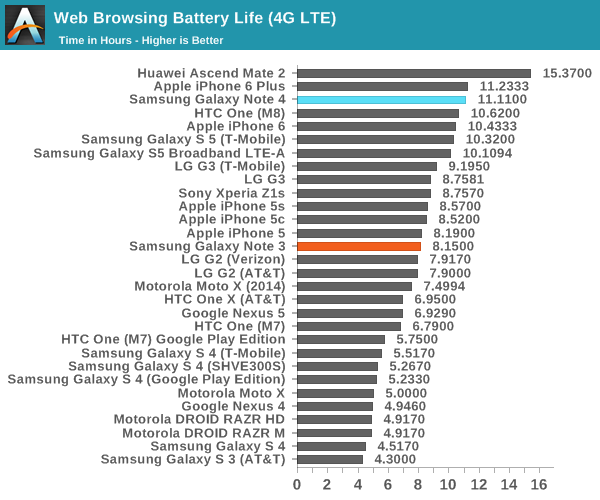
On LTE web browsing, a similar story plays out as the Galaxy Note 4 is able to keep up with the competition and delivers the massive improvement that we’ve generally seen from the transition to Snapdragon 801 and 805.
While the web tests are well-worn by now, we’ve added two additional tests to the battery life suite in order to get a better picture of SoC-bound battery life. To this end, we use an infinite loop of T-Rex on-screen to replicate a GPU-intensive scenario and Basemark OS II’s battery life test to simulate a CPU-intensive scenario.
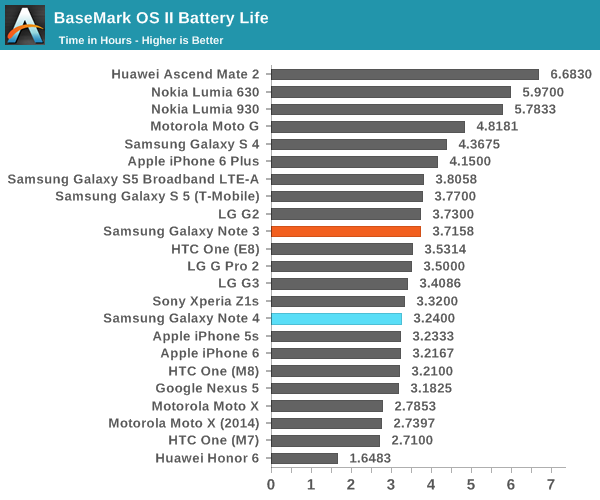
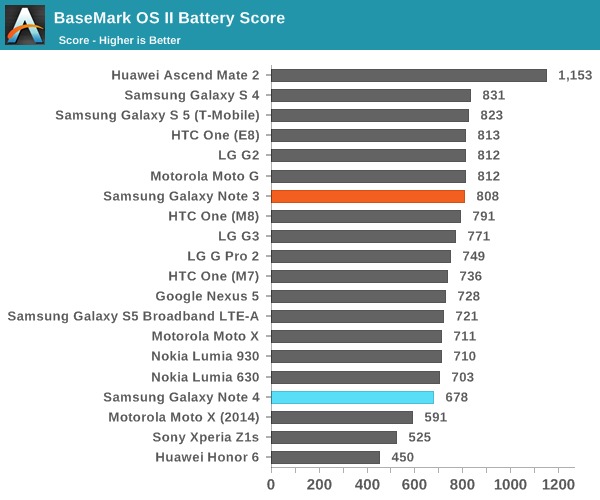
In the case of the Basemark OS II test, we see that battery life under a sustained task ends up a bit lower than we expect, which seems to suggest that in CPU-bound tasks the Note 4 doesn't have much better efficiency when compared to the Galaxy Note 3. This seems to be self-evident, as the CPUs are quite similar and the process technology used is largely similar when comparing the two devices.
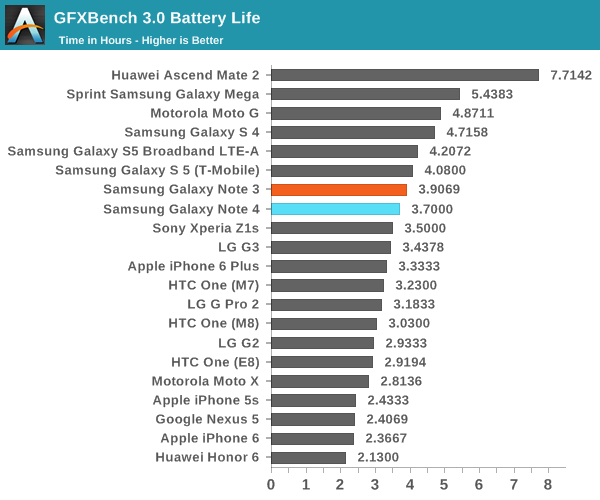
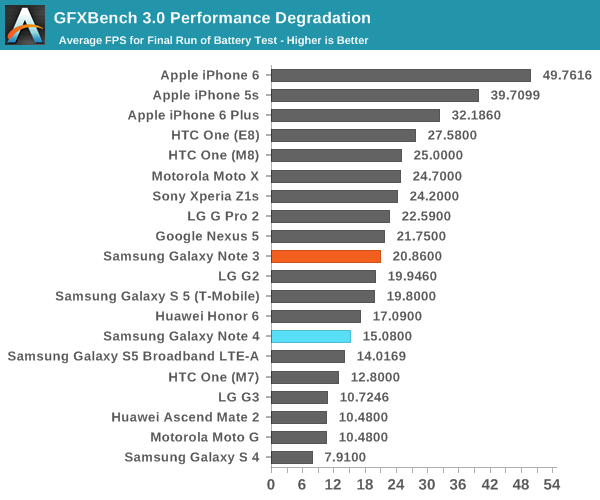
In GFXBench's endless rundown test we see that the Galaxy Note 4 trails behind in battery life when compared to the GS5 LTE-A, but looking at the end of run FPS it’s quite clear that the Galaxy Note 4’s larger surface area makes it possible to achieve greater performance.
Overall, battery life is quite good on the Galaxy Note 4. It’s a massive leap forward when compared to the Galaxy Note 3, but a relatively small one when compared to the Galaxy S5. Once again, we see that most of the benefits in battery life will come from scenarios where power draw isn’t strongly influenced by the display.
Charge Time
As a part of the overall battery life story, it's important to consider the time it takes for a battery to fully charge. If a phone's battery charges slowly then scenarios where charge time becomes crucial will severely hurt real-world battery life. For example, if one forgets to charge their phone at night, the rate at which the phone will charge the battery is a strong influence upon actual battery life. In order to test this, we measure power draw from the time that the device under test is plugged in until it reaches a given level of power draw that indicates that the battery is fully charged.
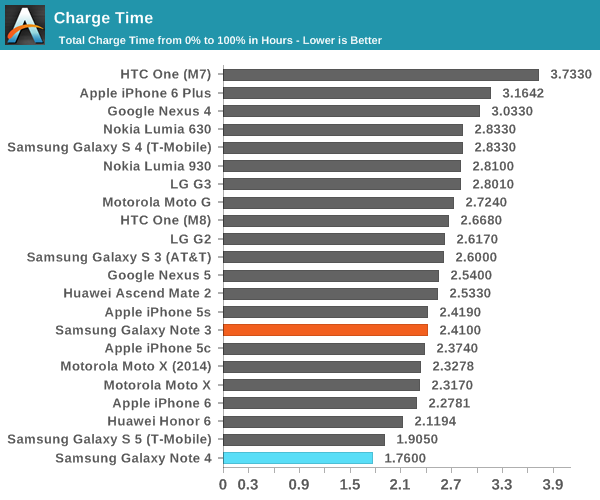
As one can see in the graph above, the adaptive fast-charge mechanism really works, although I don't see a huge benefit when compared to the Galaxy S5's charge time which was already incredibly fast. In the case of the Galaxy Note 4 it seems that it switches between a 9V, 1.64A mode and a 5V, 2A mode as needed, and most of the benefit would come from the first 50% or so of charging as power drops rapidly as the battery approaches full charge.










195 Comments
View All Comments
darkich - Wednesday, October 15, 2014 - link
Yep, different approach to low power design.Apple use just two underclocked but very beefed up, large cores, while Qualcomm uses more small, simple, but high clocked cores.
Just think about the fact that Snapdragon 805 probably doesn't draw more power than the A8, even while being clocked twice higher and built on a larger node.
If you doubt that, the Galaxy Note 4 itself is your proof - longer battery endurance than iPhone 6+(according to every other review) despite of having a modestly larger battery, supposedly less efficient OS, triple the RAM, bigger screen and larger resolution panel.
There's probably no way it could achieve that if snapdragon 805 was any less efficient than A8
darkich - Wednesday, October 15, 2014 - link
One more thing.. the CPU benchmarks posted here are nothing but a single threaded Web scripts. Which means, almost entirely dependant on software optimization and single core performance.If you want a good raw performance indication of the CPU setup itself, look up Geekbench.
There the Snapdragon 805 easily beats the A8 in overall score.
The A8 beats it even more easily in the single core part though.
KPOM - Wednesday, October 15, 2014 - link
Not many apps are designed for multicore support. Also, Apple chips run at top speed for longer. It's like comparing Carl Lewis to Paula Radcliffe. Lewis can run faster for short bursts but Radcliffe has more endurance and is still running at the top of her game after 26.2 miles.KPOM - Wednesday, October 15, 2014 - link
Not necessarily. The biggest drain on the battery is the screen. OLED is more efficient than LCD. So perhaps the Qualcomm CPU is less efficient but Samsung makes it up in the display. Now that Samsung seems to have solved the saturation issue perhaps the real story is that if Apple and Samsung were still partners instead of frenemies the battery life on the latest iPhones would be absolutely amazing instead of just good considering the smaller batteries they use.tralalalalalala40 - Saturday, October 18, 2014 - link
not more efficient when browsing the web (white background)tralalalalalala40 - Saturday, October 18, 2014 - link
Because you were lied to by a 100 billion dollar marketing machine. more megapixels is not better (if you don't account for pixel size etc.). more RAM is not better (if you don't account for fast memory compression techniques). more clock speed is not better (if you don't account for electromigration and current leakage, etc. in the transistors).techcrazy - Wednesday, October 15, 2014 - link
Samsung amoled display doesn't appear as sharp as other LCD display. It's because of their PenTile subpixel layout. Their PentTile subpixel layout is lower than a conventional RGB stripe, so true subpixel density increases around 20%. - So basically Samsung's QHD display only 20% sharper than FHD display which has RGB stripe where as LG's QHD display is nearly 80% sharper than FHD display which has RGB stripe. LG's QHD display is the true QHD display and Samsung's QHD is the fake QHD display.grayson_carr - Wednesday, October 15, 2014 - link
Doesn't change the fact that the G3 display isn't very well calibrated, has very poor contrast, and has a terrible oversharpening algorithm that makes things look weird.MattL - Wednesday, October 15, 2014 - link
Good review... two things though:1) Your screen analysis results differ from display mate in an oddly large way, different review unit calibrations maybe? They found it to rate much better on accuracy results than here.
2) Battery life results differ a bit than most other sites, they find the note 4 does better than the iPhone 6. In fairness the web browsing results is where it rates the lowest which is where the iPhone 6 barely beats it here, so that doesn't different too much.
Why don't you do a video battery life test? Or a mixed content test. These are areas that OLED screens should do much better due to white screen vs black energy efficiency, something display mate analyzed in much more detail.
Arcetnathon7 - Wednesday, October 15, 2014 - link
Don't you think strange that diplaymate submit the test weeks before the launch ?Same thing with Galaxy Alpha and GSMarena review.
I really suspect Samsung chosing prototypes. Every other review after launch never meet those results.